Battle of Saigon (1968)
| ||||||||||||||||||||||||||
The First Battle of Saigon, fought during the Tet Offensive of the Vietnam War, was the coordinated attack by communist forces, including both the North Vietnamese Army and the Viet Cong, against Saigon, the capital of South Vietnam.
Background
In late January 1968 the Vietcong launched the Tet Offensive attacking U.S. and South Vietnamese positions across South Vietnam.
Saigon was the main focal point of the offensive, but a total takeover of the capital was not intended or feasible. They rather had six main targets in the city which 35 battalions of Vietcong were to attack and capture: the ARVN Joint General Staff compound near Tan Son Nhat International Airport, the Independence Palace, the US embassy, the Tan Son Nhut Air Base, the Long Binh Naval Headquarters and the National Radio Station. Because it was Tết (the Vietnamese New Year), the sound of firecrackers exploding masked that of gunfire, giving an element of surprise to the Vietcong attacks.
Battle

The Vietcong launched 35 battalions at Saigon. Sapper Battalions and the local forces attacked the Presidential Palace, the National Radio Station, the US Embassy, and other principal targets.
The 5th Vietcong Division launched an attack on the military bases at Long Binh and Biên Hòa Air Base. The North Vietnamese 7th Division launched an attack on the US 1st Infantry Division and the ARVN 5th Division at Lai Khê. The Vietcong 9th Division attacked the US 25th Infantry Division base at Củ Chi.
Adams photograph
The fighting in Saigon produced one of the Vietnam War's most famous images, photographer Eddie Adams' Pulitzer Prize-winning image of the summary execution of a Viet Cong prisoner on February 1, 1968.
Nguyễn Văn Lém was captured by South Vietnamese national police, who identified him as the captain of a Viet Cong assassination and revenge platoon, and accused him of murdering the families of police officers. He was brought before Brigadier General Nguyễn Ngọc Loan, the chief of the national police, who briefly questioned him. General Nguyễn then drew his sidearm and shot the prisoner. Nguyễn's motives may have been personal; he had been told by a subordinate that the suspect had killed his six godchildren and a police major who was Nguyễn's aide-de-camp and one of his closest friends, including the major's family as well.
Present at the shooting were Adams and an NBC television news crew. The photograph appeared on front pages around the world and won eight other awards in addition to the Pulitzer. The NBC film was played on the Huntley-Brinkley Report and elsewhere, in some cases the silent film embellished with the sound effect of a gunshot. General Westmoreland later wrote, "The photograph and film shocked the world, an isolated incident of cruelty in a broadly cruel war, but a psychological blow against the South Vietnamese nonetheless".
Aftermath
By early February, the Communist high command realized that none of their military objectives were being met, and they halted any further attacks on fortified positions. Sporadic fighting continued in Saigon until March 8. Some sections of the city were left badly damaged by the combat and U.S. retaliatory air and artillery strikes in particular. The Chinese district of Cholon suffered especially, with perhaps hundreds of civilians killed in the American counterattacks.
As cited in the Spector book on page xvi, "From January to July 1968 the overall rate of men killed in action in Vietnam would reach an all time high and would exceed the rate for the Korean War and the Mediterranean and Pacific theaters during World War II. This was truly the bloodiest phase of the Vietnam War as well as the most neglected one."
The Vietcong attacked targets in and around Saigon with much success during the May Offensive from 5–30 May 1968.
In popular culture
The battle is depicted in the first-person shooter, NAM, as its last level.
It also appears in the 2004 video game Battlefield Vietnam, which features a multiplayer map titled Saigon - 1968 that is loosely based on the battle which in turn features the U.S. Army and the Viet Cong as the playable factions.
References
Bibliography
- James R. Arnold (1990). The Tet Offensive 1968. Praeger Publishers. ISBN 0-275-98452-4.
- Ronald H. Spector (1993). After Tet. Free Press. ISBN 0-02-930380-X
Coordinates: 10°46′01″N 106°40′01″E / 10.7669°N 106.6669°E
